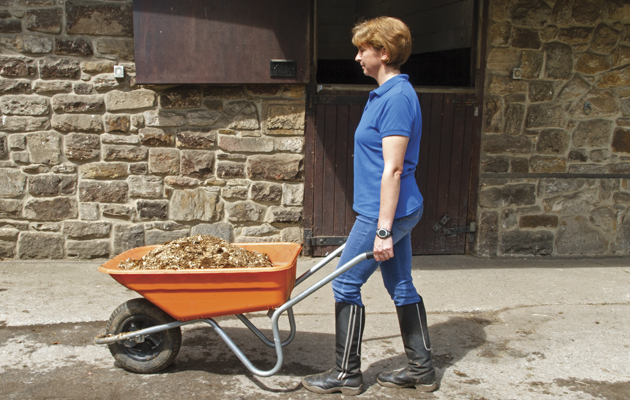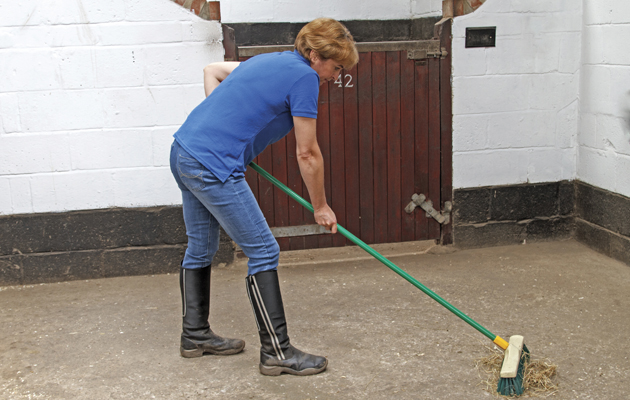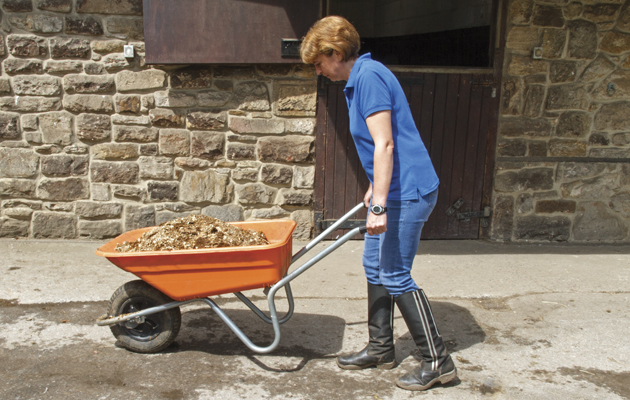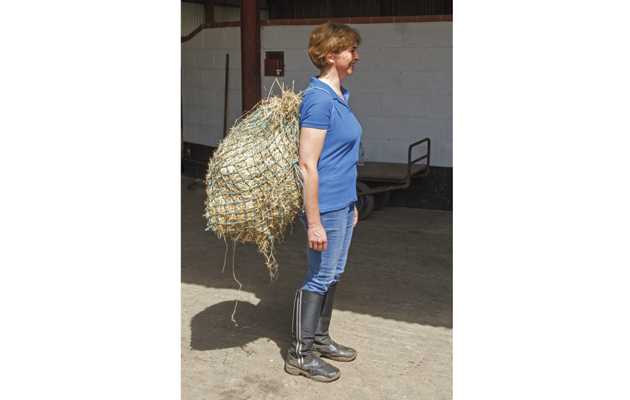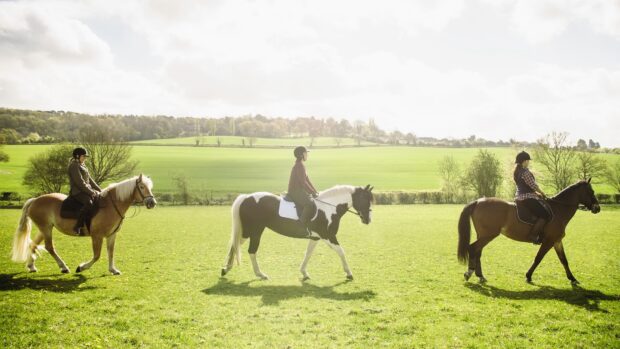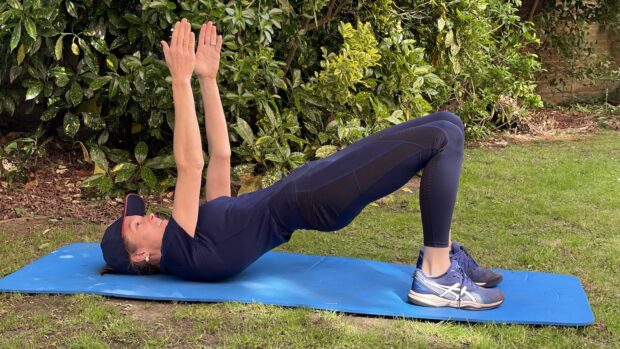In her new book 'Equestrian Pilates: schooling for the rider', Sue Gould-Wright looks at ways that Pilates can help you with tasks around the yard — from pushing wheelbarrows to mucking out
The jobs we do around the stable yard to make sure our beloved equine is warm, clean, comfortable, well fed and watered are some of the tasks most likely to wreak havoc on our bodies.
For example, hands up anyone who has picked up a bale of bedding with ease and carried it to the stable? Nobody? Well, hands up those who have managed to get their arms around a bale of bedding and waddled in the most ungainly manner to the stable, stopping occasionally to correct the inevitable ‘Aargh! I’m about to drop it’ moment? Yes, me too!
Lifting bedding or bales of hay is one of those jobs that unless you are very tall, with very long arms and very big muscles, you cannot really do correctly. I have tried to look at all possible methods and really the only safe way of handling these bulky items is to use a sack-trolley or wheelbarrow or for two people to lift them together.
If you have no option but to move them without assistance, concentrate on engaging your core and shoulder stabilisers before you proceed.
There are, however, other stable yard jobs I can help with.
Sweeping
How not to sweep: photo one
A better sweeping posture: photo two
Excuse my hideous over-acting in photo one but I was trying to mimic the main faults I see. Firstly you will see that I am using quite a lot of effort with my upper shoulder muscles and neck, my upper trapezius in particular; my shoulders are up by my ears and I am taking quite a bit of strain through my arms. I have automatically stepped forward to push off with my favoured leg – we all have one! The other thing to note is my back is rather hunched – no sign at all of the neutral curves – and I can tell you that there was no core working.
If you compare the photos you may also notice that I am taking my weight backwards in photo one but in photo two my posture is more upright, my core is engaged and I have stepped forward with my ‘unfavoured’ leg. Because we do all have one side we favour, the more we submit to the use of this side over the other the more wonky we will become. If you look at photo one you can see clearly that the pelvis is twisted.
Think about how often you sweep, muck out and push wheelbarrows (and do other non-horse-related activities like walking up stairs) then it doesn’t take long to become very one-sided. It will take time to get used to using the other leg as you will have to consciously choose it and build up the muscle memory to become proficient at using the other side of the body. I should also state the obvious, which is: once you have got used to using the other leg, remember to alternate between the two or you will end up swapping one favoured leg for another!
The other point to note in photo two is my shoulder position — I have now drawn my shoulders down. All in all, this is not only a more comfortable way to sweep but it is more efficient. Instead of using small muscle groups, like those in the arms, neck and shoulders, you can get those big, powerful back, leg and core muscles working. Notice how I am leaning more forward in photo two, using the weight of my body to sweep rather than exhausting my arms.
Mucking out
How not to muck out: photo three

A good mucking out posture: photo four
As with sweeping, the over-use of shoulders, neck and arms is very apparent in photo three. You will also see that the back position is hunched, no core muscles are working and I am again leading with my favourite leg. If you are mucking out a particularly wet and/or dirty bed you do not need me to tell you that it can be heavy work and if you are just using the smaller muscles of the arms, shoulders and neck rather than getting the larger back and core muscle groups involved, you will soon tire.
In photo four you will note the more neutral body and shoulder position. I have again changed the leading leg and have also swapped arms – a good habit to get into; the more you practise the easier it will become. Note the whole body is now involved in the activity; by taking the weight into the front foot I can take the effort away from just the shoulders and arms.
Pushing wheelbarrows
Bad wheelbarrow pushing; the barrow is being ‘carried’: photo five
Good wheelbarrow pushing; the body is being used correctly to push rather than carry the barrow: photo six
Oh, this is my favourite thing to nag clients about. I am so conscious of it I had real trouble doing the bad pose for photo five. What am I talking about? Those of you who ‘carry’ your wheelbarrow rather than push it – you know who you are! You insist on lifting the handles so high that the benefits of having a wheelbarrow are lost because you are using so much shoulder and arm work you might as well be carrying a large bucket – badly!
As you will also see in photo five, there is often a tendency to stoop when you are pushing and not engage the core. As with the previous activities, the favoured leg is leading the task and, because this is generally a heavier activity, then it is even more important to change.
When you are pushing your wheelbarrow think about all of the cues for your good standing posture: neutral spine, neutral pelvis, engaging your core. As you bend to take hold of the handles, ensure you bend from the knees and hips rather than hunching through the small of your back, and engage the core a little more strongly as you push upright through the legs to take the weight of the barrow. Also, draw the shoulder blades down and in towards your waistband as you take the weight as this should stop you from lifting with top of the shoulders and the neck. Finally, remember which leg to step forward with first to ensure your favoured leg doesn’t do all of the work.
Carrying buckets and haynets
Bad bucket carrying: photo seven
Bad haynet carrying: photo eight
Good bucket carrying: photo nine
Good haynet carrying: photo 10
I have grouped these two tasks together as they have one common element, which is: we often carry the offending items on one side only. We either lean our body away from the item we are carrying to counterbalance the weight of the item, or we allow ourselves to tip toward the weight. (Photos seven and eight) Either way, if this is repeated day after day we will eventually become tighter and shortened to one side.
Before picking up your bucket or haynet, engage your core. As you bend to pick it up, bend the knees and keep your back as neutral as possible. Push yourself upright using the leg muscles, engaging the core more as you take the weight of the item. Once upright, holding your net or bucket, check that you haven’t allowed the tops of the shoulders to overwork. (Photos nine and 10)
With haynets I often see people holding the cord diagonally across the body, using it as an extra tool to help carry the burden. You could try what I do and tie the end of the cord halfway down the net so that you have a strap you can put over your shoulder (see photo 10). Even this is not ideal as you are still loading one side only but it is better than the alternative.
I hope that you are now starting to see that the bad and good ways to do your yard tasks are quite similar across a wide range of jobs.
Bad = over-use of shoulders, poor back posture, no core working, favouring one side.
Good = use of shoulder stabilising muscles, maintaining a neutral spine where possible, always starting a task with the conscious thought of engaging your core (especially if it is heavy work), alternating your favoured leading leg.
Other daily tasks
When looking after a horse there are so many repetitive tasks involved (grooming, picking out hooves, leading, leaning over feed bins, etc.). However, as we have already seen, the more you think about how you use your body well, the stronger and more able you will be to continue carrying out these tasks for years to come. Check that you are doing the following.
• Using your core muscles.
• Keeping your posture as neutral as the task will allow.
• Ensuring your shoulder stabilisers are working and that raised shoulders (shoulders up by your ears) are a thing of the past.
• Alternating your push-off (leading) leg.
• Working your arms equally.
• Using your wheelbarrow as a wheelbarrow.
• Making use of a big, strong giant to carry your bedding!
This is an extract from Equestrian Pilates – Schooling for the Rider by Sue Gould-Wright.
Publisher: published by J.A. Allen
Price: £15.99
Visit: www.allenbooks.co.uk
